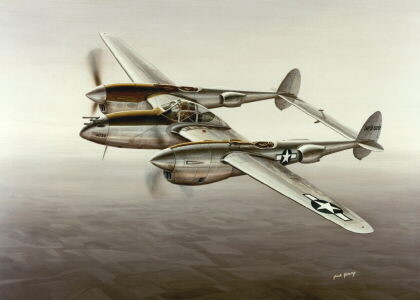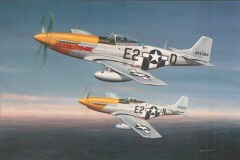|
Jack's Story
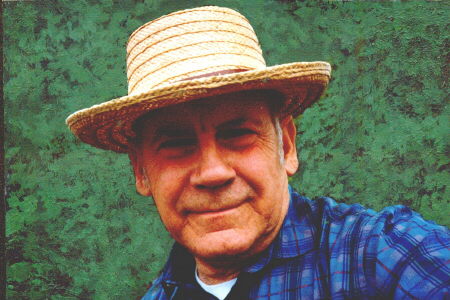

JACK THE KID:
My memory begins as a youngster living on a ranch in Eastern Oregon.
The horses, the barn and corrals, the rolling wheat lands, the harvest
hands, the thunder and lightning storms, all remain strong memories with
me today.
One thing I can't remember is not having a desire to draw. It seems
to have always been there. I was also the kid that after discovering
airplanes would walk 5 miles to the airport and 5 miles back, just to be
near any kind of flying machine and the heroes that flew them. My
youth was filled with catering to my passion of drawing, sketching and
building model airplanes.

JACK IN THE SERVICE:
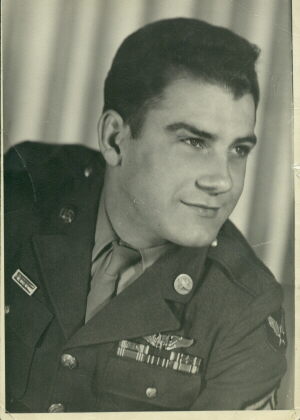
Just out of high school and along came world war II and my induction into
the Army Air Corps. By joining the Air Cadets my dream of flying
was about to be realized. However, fate would have it that the Air
Corps decided they had enough pilots, so out and into Gunnery and B-24
bomber training. It was then off to Europe and the 389th Bomb Group, 565th
Squadron for my first mission on January 1st, 1945.
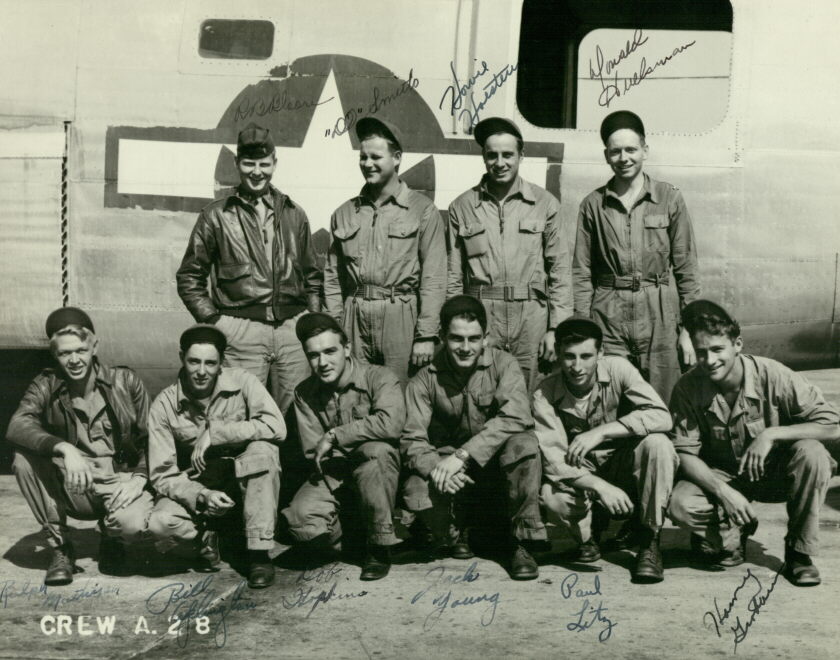
The following 19 missions over the Continent varied from milk runs to many ways to get yourself hurt beyond repair. Then came
number 20. This was my last mission, March 24, 1945. We left
our base at Hethel, England, on a low level mission to drop supplies to
our paratroops across the Rhine River in Germany. Viewing England,
the English Channel, France, Belgium and Germany at low level in a B-24 bomber nose turret was unforgettable. As we approached
Wesel and the drop zone, the activity became intense. Streams of
transports, gliders landing (some crashing), two German soldiers running
and diving over a stone wall as our 14 bombers roared overhead. We
just cleared the chimneys of the devastated town of Wesel, then the drop
zone appeared, an open field bordered by forests on both sides.
It was empty. The paratroops were not there.
Our lead plane ordered to make a large 360 degree turn and then drop the
supplies, paratroops or not. We started across the field again at
about 150 feet altitude. Suddenly, over the noise of the engines,
I heard what sounded like the banging of pots and pans. Puzzled by
the racket, I began looking about and was surprised to see holes appearing
in the engine nacelles and wings. The woods were loaded with German
troops, (they couldn't miss with a hand gun!). Tracers flashed up
from 20 mm cannons. The first shots hit the aircraft
to our right, blowing the number two engine completely off. They
veered left 20 feet above in an almost vertical left bank and disappeared
from view. The cannons next hit the lead aircraft, blew off the entire
left fin and rudder (they staggered off to our right). We were next.
a few seconds had elapsed from the time the shooting started before my
mind began to function. We had definite orders not to shoot at anything
on the ground (afraid we might shoot our own troops). I flipped on
my gun switches, swung the turret toward the cannons. Suddenly my turret
shattered. I will always remember two tracers coming slowly like Roman
candles slashing into my turret, the Plexiglas shattering, the metal bent
and torn as the projectiles entered the bombardiers compartment behind
me. The pilot was shouting over the intercom, "we're crashing!"
I had difficulty opening the turret doors but forced them enough to get
through and was relieved to see the bombardier unhurt - we just stood grinning
at each other. Getting to the flight deck was
quite interesting as the un-dropped load of supplies in the bomb bay was on fire, but we got through with just
a little singeing. Once into my crash landing position behind the
co-pilot, I could see we had trouble. Number one engine was feathered,
number two was on fire, number three was running wild, number four was on fire and wind milling. We had
no rudder or elevator controls.
A large field with a row of trees along a road appeared directly in front of
us. As we reached the trees, the aircraft rolled,
the wing smashing into them. I regained consciousness to the sounds
of explosions, bullets firing, English and German voices, and someone cutting
off my flying jacket. I couldn't see a thing - I passed out again.
(My eyes were swollen shut, my eyelashes, eyebrows and hair were burned to
stubble).
The next time I came to, my head was completely bandaged with only a slit
for my mouth, both hands bandaged up past the wrists. I was questioned
by someone. I
had a severe concussion, burns on my head and hands, a semi fracture of
the skull, a very painful back, a collapsed lung, a deep gash across my
right eyebrow, a gash on the back of my head.
Only
the copilot, the bombardier and myself survived the crash. The bombardier
died later. To this day, I couldn't tell anyone how I
got out of the airplane. In the hospital, I was told we had crashed
into an ammunition dump which explains the explosions I heard. My time in the
service of our country was completed by spending a few weeks in hospitals
in Paris and England.

How The Internet Brings People Together
|
For 54 years I had no knowledge of the events after we hit the trees. Recently I received an E-Mail from Mr. Peter Loncke of Belgium. He has spent a considerable amount of time researching crash sites of the aircraft that were shot down on 3-24-45. In his research on the internet he ran across my page and thus began a very rewarding experience. Without the power of the internet, none of what follows would have been known to me.
Not only did Peter find our crash site, but he found a German farmer that actually witnessed our bomber crash. He was 16 years old at the time. It seems unbeleivable that after this many years I have now found most of the information about what happened after we crashed. Thanks to the efforts of several special and caring individuals. Peter Loncke - Belgium Air Force, Clark Harbach - Colorado, George Kasparian - Massachusetts, Robert Vance - California, Lt. Col. Arthur Arend - Ohio, Captain Jim Flynn - Texas and T/5 George Rollo - Florida. I now find we crashed near Sevelen, Germany in allied occupied area. Three soldiers of the 131st AAA unit, Lt Col. Arend, Capt, Flynn & T/5 Rollo saw us comming down on fire and in serious trouble. They jumped into a Jeep & raced to the crash site. We had crashed between rows of TNT in an ammunition dump! Large columns of fire and smoke was coming from the burning aircraft. Both wings were torn off, the tail section was broken off and the fuselage was split open.Arend, Flynn and Rollo with complete disregard for their personal safety pulled seven of us out of the A/C before the flames forced them out. One body was found in the field with a partially opened chute. The Pilot was left in the A/C as it was obviously to late for him.After getting us in an ambulance and a truck they said "Lets get out of here!". The fire was causing the bullets and tracers to cook off causing minor explosions. Small blocks of TNT were also blown flaming into the air.
They ran and approximately 100 yards from the A/C suddenly 74 Tons of TNT exploded! They were blown tumbling for about 50 feet horizontally. Thank God they were not seriously injured except for shattered eardrums.
|
 |
Several people were killed that were trying to contain the fires, including some German farmers that were trying to help out. A farmhouse about 1000 ft. away had the roof blown off and the trees we crashed through were blown flat. The aircraft right wing and nacelles is just visible on the very right side of the picture. |
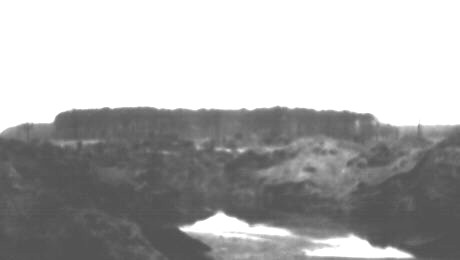 |
The explosion caused a crater 100 yds. long, 25 yds. wide and 15 ft. deep with water welling up from the shattered rock strata. |
I was taken in the ambulance to the 119th evacuation hospital at Kamp, Germany. A few days later I was flown to a hospital in Paris, France. Later I was flown to a hospital in Southern England where I spent a couple of weeks in a burn ward.
Released from the hospital and back to Hethel Airbase on the train I created a lot of interest from other passengers. The wounds, the swelling and the burns were very visible, I answered a lot of questions.
I now understand why I heard the bullets firing, the small explosions and the German voices in my semi-conscious condition right after I was pulled from our crashed aircraft.
I can never thank the fellows enough that saved me from the crash. They received the soldiers medal for their courage, it should have been the congressional medal of honor.

JACK THE ARTIST:
My plan to earn my fortune in the lumber industry was thwarted by the injuries to my back, so it was off to school with the aid of the GI bill. First to the University of Oregon studying art and then to the Art Center School in Los Angeles studying Industrial Design. My first job out of school was with North American Aviation as an ink tracer. Within six months I was one of three artists doing full color paintings for the company.
Three years for North American, then off to Boeing for five years. At Boeing I did aircraft paintings and designed exterior markings from many of the worlds airlines.
After Boeing, I went to work for the Lockheed Missiles and Space Division in Sunnyville, California. For Lockheed, I painted many inner and outer space paintings, including man's first walk in space which appeared in many newspapers and magazines. During this period I entered three TIMA national art competitions and won all three. I had entered a TIMA competitions earlier (and also won), which amounted to four first place awards for the four times I entered the competition.
A desire to be closer to airplanes then took me to Aero Union Corp. in Chico California. Aero Union was operating converted military aircraft for special purpose operations and aerial fire fighting. Aero Union then owned the largest fleet of privately owned B-17's in the world (seven in all). At Aero Union, I did just about everything from bucking rivets, to running new wiring, to actually applying paint to an airplane. In the summer I was privileged to fly co-pilot on one of the B-17's, putting out wild fires all over the Northwest.
An opportunity to do paintings of new and emerging high technology took me to Lawrence Livermore Laboratories. There I spent one of the most prolific periods of my life. While working full time, I decided to do some landscape paintings for various art galleries. In one year, I ended up painting and selling 158 landscapes. Four years of freelance painting ensued, then It was off to new challenges at Sandia National Laboratories and more high tech paintings. Sandia, art galleries, commissions from individuals and corporations kept me busy for the next 11 years to retirement. So there you have it. My Aviation Art hangs in the Air Force Museum, the Navy Air Museum and The Pentagon. My most prolific days are behind me, but just maybe I can share some of the works in my private collection through the prints I'm offering. |
 |





